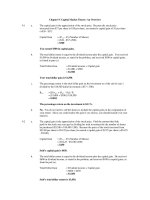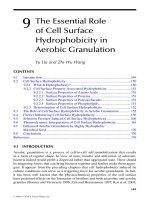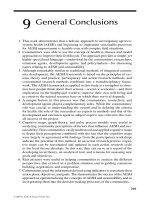Introduction to Smart Antennas - Chapter 9 pdf
Bạn đang xem bản rút gọn của tài liệu. Xem và tải ngay bản đầy đủ của tài liệu tại đây (410.53 KB, 6 trang )
149
CHAPTER 9
Commercial Availability of Smart
Antennas
Smart antenna systems are designed to relieve capacity strain in cell sites experiencing heavy
and imbalanced traffic distribution. Since traffic tends to vary considerably within a network,
at an individual cell site and over time, it is critical for wireless service providers to allocate
efficiently infrastructure and spectrum resources to meet network capacity and performance
demands.
Although smart antennas date back since the late 1950s, it is only because of today’s
advancement in powerful low-cost digital signal processors, general-purpose processors (and
ASICs – Application Specific Integrated Circuits), as well as innovative software-based sig-
nal processing techniques (algorithms), that smart antenna systems are gradually becoming
commercially available.
Several papers and studies in the area have been published in the recent years and a
growing number of companies are studying MIMO systems for future use. Several companies
have been created recently that are trying to commercialize MIMO systems and a number of
larger companies are also studying this area. In [94] the author well clarifies the main reasons
which explain why smart antenna-enabled systems have not yet been deployed more widely.
These are repeated here, verbatim, as stated in [94]:
r
“DSP and CPU speeds need to be fast enough to handle the increased computations
needed forsmart antennaalgorithms tobe ableto beimplemented inrealtime. This was
a big problem until 1999 or so, particularly for low-cost solutions. However, computing
power has now progressed to the point where smart antenna systems can feasibly be
installed using inexpensive processors.”
r
“The value proposition provided by smart antenna systems needs to outweigh the
additional cost of a smart antenna system. In the early days of advanced mobile phone
systems, one base station could cover a large area and there was no need for multiplying
the capacity of a base station. Today, when microcells and picocells need to be used at
times and spectrum is a precious commodity, the differentiation that smart antennas
150 INTRODUCTION TO SMART ANTENNAS
provide justifies the additional cost in a variety of scenarios. As the value of the
capacity/range of a system grows to clients and the cost of implementing such systems
drops due to continual advances in the field, it is expected that the usage of smart
antennas will continue to grow.”
r
“The number of people that truly understand how smart antennas work is limited.
Each year the number of people in this group grows, especially due to funding research
in universities and commercial projects, but the supply of experts is limited. A serious
problem is the lack of universities offering classes in smart antennas.”
r
“Decision-makers in the wireless industry have experienced a high level of scepticism
about implementing smart antennas, partly due to a lack of understanding on the subject
and partly because the systems were not proven to work in commercial environments.
The successes have helped to pacify those worries, as have the various test-beds created
by academia.”
A company that has been able to successfully commercialize smart antenna systems for
cellular base stations worldwide is ArrayComm (an innovative wireless technology company
located in San Jose, California whose chairman, CEO and co-founder is the inventor of the
cellular phone, Martin Cooper). The company has patented the smart antenna system under
the name of IntelliCell
, and as of today, it has deployed over 275,000 IntelliCell
base
stations in USA, Japan, China, Taiwan, Australia, South Africa, Thailand, Middle East, and
Philippines. It is considered a fully adaptive smartantenna technology which dynamically adjusts
signal patterns to and from the desired subscriber, creating a concentration of energy focused
exclusively on the subscriber for efficient delivery of voice or data services. The technology can
concentrate energy on people even as they move, reducing radio interference and giving users
the best signal quality possible [45].
ArrayComm’s IntelliCell solution uses an array of ordinary antennas to continually map
the RF environment. Mapping allows the system to focus on the subscriber, using the environ-
ment to coherently combine the signals on the subscriber’s device. Less power is transmitted,
and less interference is generated, resulting in superior quality of service for the user. A base
station utilizing IntelliCell employs a small collection (array) of simple, off-the-shelf antennas
(typically 4 to 12) coupled with sophisticated signal processing to manage the energy radiated
and received by the base station. This improves coverage and signal quality and mitigates
interference in the network on both the uplink and the downlink.
ArrayComm has shown that its IntelliCell
technology has significantly improved ca-
pacity and coverage; in fact, on the average, an IntelliCell-enabled network can deliver three
times the capacity of a conventional system or up to twice the coverage area, depending on the
air interface being deployed.
COMMERCIAL AVAILABILITY OF SMART ANTENNAS 151
(a) (b)
FIGURE 9.1: (a) Smart antenna array with 12 elements developed by ArrayComm Inc. and (b) Joint
TD-SD Multiple Access scheme by ArrayComm [45].
Moreover, commercialized GSM base stations incorporating ArrayComm technology
have proven up to 600% greater capacity than standard GSM networks and frequency reuse
of 1 across cells without frequency hopping. The expanded range of IntelliCell-enhanced base
stations means fewer cell sites are required resulting in lower costs. It uses low power amplifiers
resulting in higher reliability and lower costs.
This enhancement provides enormous potential revenue gains for GSM network opera-
tors wanting to maximize their infrastructure and spectrum investments. Company’s executives
claim that their equipment cost is just 15% higher than conventional equipment for up to three
to seven times capacity improvement. Fig. 9.1(a) shows the smart antenna manufactured by
ArrayComm Inc.
As previously stated, SDMA is an enhancement to the more common TDMA, FDMA,
and CDMA methodologies. Adding a spatial dimension to these accessing schemes creates
an additional method of identifying each individual user. This means that instead of a single
user being served by one unit of time, frequency or code, that same single-unit can now serve
multiple users, identifying each by their unique spatial signature [45]. Fig. 9.1(b) illustrates the
joint Time Division and Spatial Division Multiple Access scheme realized by the IntelliCell-
enabled network. For further details on ArrayComm and its products refer to [45, 227].
Another company that has made smart antenna commercially available is Metawave
Communications located in Redmond, Washington. The company’s smart antenna offerings
provide wireless operators, tower providers and infrastructure manufacturers with cost-effective
solutions that maximize capacity and performance, improve quality and increase efficiency
of CDMA, GSM and third generation (3G) wireless networks. Metawave’s smart antenna
solutions have been deployed in 14 of the top 20 markets in the US and five of the nine regions
in Mexico.
152 INTRODUCTION TO SMART ANTENNAS
The company’s smart antenna system is patented under the name of Spotlight
and it
has installed, as of October 2002, 420 Spotlight
base stations in USA, Central and South
America, and Russia. Spotlight
customizes sectors to balance traffic loading. In other words,
it is not a fully adaptive smart antenna but a Switched-Beam smart antenna which allows traffic
load balance at cell sites and reduction of handoff overhead. Spotlight
provides cellular base
stations retro-fitting at a lower cost since it requires less digital signal processing than fully
adaptive systems.
Systems with Spotlight
deployment have delivered capacity gains of up to 50% in
three-sector sites and over 90% in six-sector sites for CDMA. For further detail on Metawave
and its products refer to [227, 228]. Reports from Metawave claim up to a three times capacity
increase with adaptive beam-forming. Fig. 9.2 illustrates the functional diagram of Spotlight
.
Another product by the same company is the SmartCell
. It is a targeted, sector-by-
sector smart antenna solution for cellular and PCS networks that enables wireless operators to
sculpt or shape a cell site’s coverage pattern in a way that delivers greater performance, capacity
and coverage benefits. The SmartCell system comprises a set of phased-array antenna panels
with a customizable “personality module” that establishes an optimally sculpted antenna pattern
for a particular sector. A software tool is used to determine the optimal sector antenna that
is captured in the personality module and installed into the back of each antenna panel. By
Spotlight
2200
Antenna arrays
Base
Station
Remote System
Configuration
FIGURE 9.2: The functional diagram of Spotlight
[228].
COMMERCIAL AVAILABILITY OF SMART ANTENNAS 153
FIGURE 9.3: The use of standard or custom patterns to fit the topology of sector coverage [228].
swapping out the personality module, the embedded Cell sculpting technology in the systems
provides flexibility to change antenna patterns for determination of the optimal in response
to the changing RF environment [228]. This technology is the key to enabling operators to
shape a cell’s coverage pattern in a way that delivers greater performance, capacity and quality
benefits than those of off-the-shelf antennas. Cell sculpting technology takes drive test data
and network information to estimate the optimal antenna pattern. The optimal pattern is then
transferred to the personality module that is inserted into the back of each antenna panel.
Fig. 9.3 illustrates the SmartCell concept.
In complex RF environments without the presence of a dominant server, cell sculpting
technology helps increase server dominance in the network to reduce pilot pollution, reduce
average transmit power on the forward and reverse link, and reduce variance of transmit
power. SmartCell is ideal for complex RF environments where network topology and traffic
distributions create difficult radio management challenges. As this changes, operators can make
a corresponding change to their antenna patterns. SmartCell technology supports all major air
interfaces including CDMA, GSM, TDMA, CDMA2000, and W-CDMA.
Not only smartantennas for cellular systems havecome along way, but also smartantennas
for PEDs have made progress. Although their commercial availability has been hindered due
to its high costs, research and experiments have shown promising results. A company in Berne,
Switzerland, called ASCOM AR&T, has developed a 3-element low power smart antenna for
5–6 GHz W-LAN which is small enough for mobile terminals. The antennas are attached to a
PCMCIA card. Each single element is a bent stacked slot antenna which experiences effectively
independent fading. Finally, the beamforming is performed at RF frequencies to keep the
production costs low. Tests carried out with this product showed a superior performance over
an omnidirectional antenna like Bluetooth
TM
[229]. Other experimental projects in the field
154 INTRODUCTION TO SMART ANTENNAS
(a)
(b)
(c)
FIGURE9.4: Smart antenna developed by ASCOM AR&T (a) Single antenna element, (b) PCMCIA
card with antenna array, and (c) Smart antenna connected to a Notebook [229].
of smart antennas for W-LANs have also reported similar findings [230, 231]. Fig. 9.4 shows
the company’s development.
Finally, it should be stated that as the client’s demand for higher capacity/range in a
system grow and the cost of implementing such systems drops due to continual advances in the
field, it is expected that the usage of smart antennas will continue to grow.









